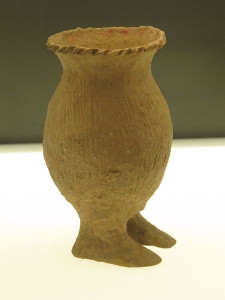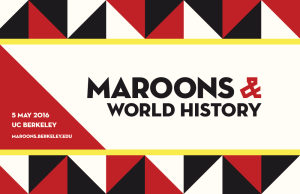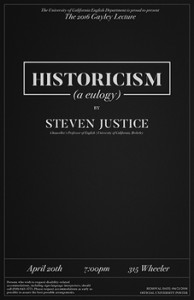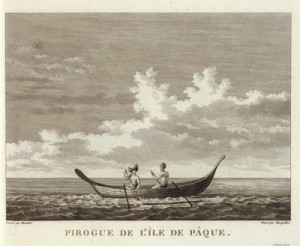by Gerhard Wolf
from the special issue Images at Work, Representations 133
Through “conversation” with a more than four thousand-year-old Chinese vessel, this essay engages with some of the fundamental principles of the discipline of art history espoused in recent decades. In particular, it situates Bildwissenschaft and thing theory and the material turn within ongoing debates on art and artifacts and delineates a more fluid approach to the study of image, object, art (Bild, Ding, Kunst).
The essay begins:

Jar on two human feet, earthenware (China, Gansu or Qinghai Province, perhaps Qijia Culture, 2nd millennium BC). Permanent Loan, Meiyintang Foundation, Inv. MYT 2095, Rietberg Museum, Zurich.
It is hard to say why I stopped in front of you so much longer than before your neighbors, while walking through the collection of Chinese ceramics at the Rietberg Museum in Zurich recently. Is it because the base of your body has the somewhat simplified shape of two human feet? They carry a smoothly protruding “belly,” which contracts upwards into a neck that widens, in turn, into a collar, the whole (some 25 cm high) formed in brownish clay, with vertical scratched lines ornamenting the body and a kind of rhythmic incision at the upper circular edges that defines the border between inside and outside. Perhaps there are some remains of color, but I am not sure about this. If there were no vitrine separating us, one could handle you, have a closer look, and, while talking to you, perhaps my voice would resonate through the cavity of your “belly.” Must speak with your curator. The label reveals that your exact provenance (Gansu or Qinghai, Qijia culture?) is as uncertain as the date of your production, which is roughly the second millennium BCE. No way to write your biography, to know about your dwelling in the nearly four thousand years of your existence; most probably you were excavated in the twentieth century and sold by an art dealer to a collector, who loaned you on a permanent basis to the museum. I am intrigued by your feet, not because they give you an anthropomorphic dimension; to my eyes, it rather works the other way round, in the sense of giving feet to a thing: in fact, I would not describe your overall body in either human or animal terms, even if I have already used such terminology for reasons of convenience and convention. There is an owl-shaped jug on your left side, and it is quite different. Your feet remind me of Bertrand Russell’s rather rhetorical question concerning how we can know that things do not disappear once we turn our back to them. I read this early in life, a time when one sometimes wonders if the tables and chairs might not walk away only to return the next morning. Well, in your “case” you would need to escape from the glass that enshrines you, a container in a container, and your steps would be short and shuffling. Even if you do not do this, your (relatively small) feet on the one hand indicate a polarity of stability and potential movement, and on the other they give your self-sufficient thingness a directionality resulting in a front, profile, and back view, thus “orienting” you in space. One cannot avoid considering them when one wants to “place” you somewhere. The feet thus have an effect similar to a handle; however, they don’t seem to be attached to you, as handles often are (as animals climbing up a vessel or hanging on its side, for example). I imagine that your feet are hollow inside, taking part in shaping the volume that the layer of clay circumscribes, becoming the jar you are, to be filled with wine or water or another liquid.
I wonder if you may be called a kind of Heideggerian thing, and what this would mean. Heidegger is concerned not with the shape or making of jars and jugs, but rather with the jugness of jugs and the thingness of things; this self-referential nature of things (as predicates of themselves) he strongly distinguishes from the “objecthood” of “objects”: the “thingness” of “things.” He mentions the handle and spout once en passant, and insists on the German verb schenken in the double sense of “pour” and “give.” However, he doesn’t work out the resulting directionality intrinsic to the dynamics of such a potential flow; he rather privileges the gathering in roundness, the thing as a ring. He may not have liked your feet either, insofar as they suggest the object standing in front of me (as Gegenstand = object), or he would not have cared about them at all. But I do, for what fascinates me about you, as my remarks suggest, is this hybrid but “unified” combination of a part of the human body with a body that does not represent a living being, animal or human, iconizing with these parts a function proper to them, for which they “stand,” and that vessel and human body share—the function, in fact, of standing, emphasizing further the nonhuman nature of your overall shape. As a historian I cannot be content with my own intuitive approach or bodily experience; I must ask what images and concepts of living bodies were current at the time of your production. A quick look around that rich collection does not offer me clear hints. As for the elegant tripods next to you, they look to me like communicating organs, standing on three points and thus easily set on a fireplace. There are Chinese ceremonial bronze food vessels, called Ding from the second millennium onwards, very rarely decorated with a human face; they usually carried dragon ornaments. Heidegger may have liked them, for they apparently correspond more to his concept of Vierung, the fourfold gathering of heaven and earth, mortals and immortals, than you do, an “innocent” jar standing in your vitrine on your feet, so to speak. Even if I like the originality of your shape, I won’t call you a work of art, but rather an artifact. However, this is not my major concern. Over the last years, I have named my research department at the Kunsthistorisches Institut in Florence “Image, Object, Art,” or in German Bild, Ding, Kunst, not because I think these terms form an inextricably fatal triangle, but rather because they can open to a rich semantic field, in a variety of constellations: as a triangle within a complex system of lines, as overlapping circles or pluri-dimensionally entangled universes. I understand “image,” “object,” and “art” as cumulative terms in a nonessentialist way, for example, embracing image and picture, object and thing, art and aesthetics. My interest is precisely to experiment with them in working out open conceptual tools for descriptive as well as analytical purposes as a way of reworking and refining the research process itself. In this way, you might be addressed as an artifact with an iconic aspect, meaning that your objecthood, if not thingness (despite Heidegger, I do not see a need for a sharp differentiation here), can be understood in aesthetic as well as anthropological categories. In fact, more generally, the techniques, practices, and aesthetics of containment are among the elementary interactions of humans and the environment, in the form of interference in, or interruption of, “flux” and other natural processes. This can happen by means of gathering and collecting; by transport, storage, and conservation of liquids or solids. Containment is thus one of the major conditions of the existence of “things”: containers or vessels are not only things in themselves; they can guarantee a relative stability of their content over time and space as well. Yet they can also be the site of metamorphoses or transubstantiation, as in the case of cooking pots. Containers can be understood as shells, constituting an inside and an outside. There is an aesthetics and poetics of containment in relation to function, transcultural agency, and biographies of objects, as well as the (not only) aesthetic practices that surround them: tea rituals, symposia or other rites of communality, pouring and drinking in religious ceremonies, measuring liquids and solids, the display and handling of drugs, packing suitcases, opening carton boxes in the archive, unloading ships, cooking pasta, or playing a violin. For the world of vessels and boxes is multisensorial, beyond the visual it involves touch, smell, taste, and, last but not least, acoustics: one thinks of musical instruments, often enshrining a volume that is essential for their production of sound, or beyond that, of the sheltering of objects by means of cases, often lined with textiles. According to Aristotle, a place (topos) is a sort of perfectly tight case enshrining or encapsulating things.
Turning to the three terms “image,” “object,” and “art,” I see the danger of fetishizing them or, rather, of following certain traditions and current practices of doing so. If art in the narrow sense of the European tradition is set as an absolute, universalist category, “image” and “thing” are easily drawn into the game, which then tends to become a fatal triangulation. My suggestion, however, is not to renounce speaking about “art” (a term with a kind of global success), but rather to try to free it from the connotations of the early modern “system” as it was established in Europe, to abandon the traditional hierarchies of artwork and artifact and to rediscover the notion of aesthetics as an open category well suited for transcultural research. If I see it correctly, there is at present a tendency toward just this in various parts of the world. Continue reading …
GERHARD WOLF is Director of the Kunsthistorisches Institut in Florenz, Max-Planck-Institut, and Honorary Professor at the Humboldt-Universität zu Berlin. His current research topics are Mediterranean and global art histories, sacred topographies in an interreligious perspective, theories of the image in religion and art, and the interrelations between artistic and scientific worldviews. His many 2015 publications include Littoral and Liminal Spaces: The Early Modern Mediterranean and Beyond (co-edited with Hannah Baader), Bild, Ding, Kunst (co-edited with Kathrin Müller), and Images Take Flight: Feather Art in Mexico and Europe, 1400–1700 (co-edited with Alessandra Russo and Diana Fane).
 Representations board members Stephen Best and Elisa Tamarkin, Associate Professors of English at UC Berkeley, will participate in an upcoming conference on “Maroons and World History.” The conference will take place on Thursday, May 5, at the Bancroft Hotel. Papers will be pre-circulated and registration is free, but required. More information and schedule details can be found here.
Representations board members Stephen Best and Elisa Tamarkin, Associate Professors of English at UC Berkeley, will participate in an upcoming conference on “Maroons and World History.” The conference will take place on Thursday, May 5, at the Bancroft Hotel. Papers will be pre-circulated and registration is free, but required. More information and schedule details can be found here.



